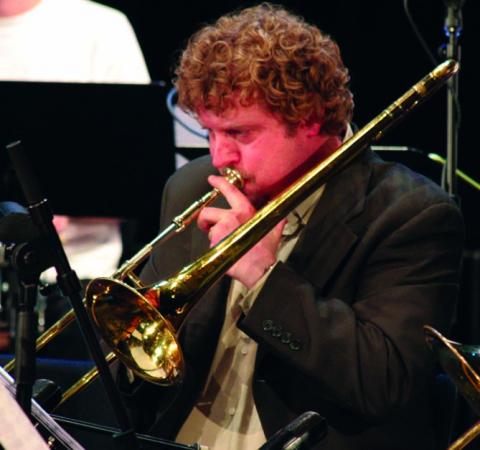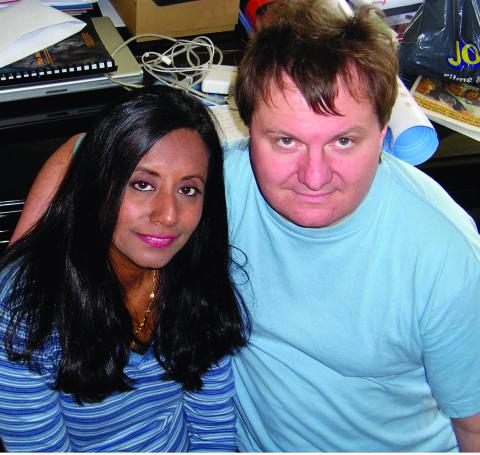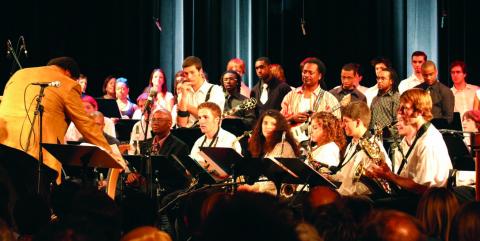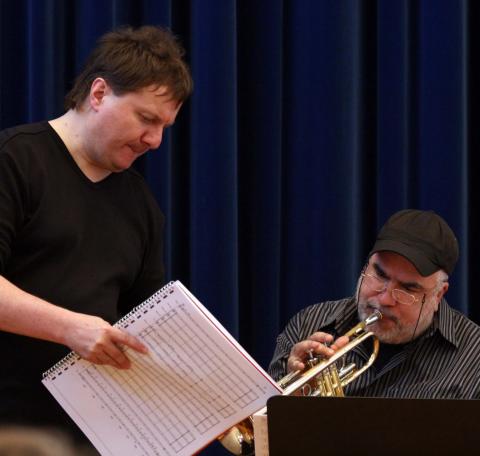The Jazzaar Festival Marks 15 Years

Trombonist Tom Garling ’86 performs on Sketches of Spain.
Walter Siegenthaler

Helen and Fritz Renold
Mark Small

Barrie Lee Hall, Jr. conducts “Word of God” during the gospel night concert.
Walter Siegenthaler

Renold and Brecker rehearse for the Miles Davis tribute.
Gildas Bocle
After completing their education, many Berklee international students return home with a zeal to share their educational experience with their countrymen. The husband-and-wife team of Fritz Renold ’87 and Helen Savari-Renold ’89 of Schönenwerd, Switzerland, is no exception. For the past 15 years, the Renolds have produced the much-celebrated festival Jazzaar, which has grown to become one of Europe’s best youth jazz education endeavors.
The Renold’s approach adds a twist to the long-standing jazz tradition of young players learning to perform by sitting in with seasoned veterans on the bandstand. Each year the Renolds have brought notable jazz musicians—including Randy Brecker, Benny Golson, Mark Soskin, Buster Williams, Tommy Campbell ’79, Victor Lewis, Miroslav Vitous ’67, Adam Nussbaum, and others—to perform as soloists and section players working alongside top teenage musicians of the Neue and Alte Kantonsschule in Aarau, Switzerland. There’s nothing like ironing out the details of new music with a mentor who is going through the same process.
The Renolds always use the festival as an opportunity to present a musical challenge. At this year’s festival in April, one of the concerts was a tribute to Miles Davis, with Brecker performing as the trumpet soloist on the Gil Evans arrangements of the Sketches of Spain and Porgy and Bess albums. The slow tempos and piquant dissonances of the Evans charts stretched the students and the pros. One such pro, trombonist Tom Garling ’86—who has worked with Chick Corea and Dizzy Gillespie, among others—remarked after the concert that it was the hardest gig he’d ever played.
The Jazzaar model has inspired scores of young participants and draws high praise from observers. At the Miles Davis tribute, Berklee’s Dean of Performance Matt Marvuglio played and served as section coach for the flute players. “I thought this music gave the students a great introduction to orchestral jazz and was a wonderful experience for them,” Marvuglio says. “The music was demanding, but they rose to the occasion.”
Each year, Fritz and others compose and arrange many original pieces for jazz orchestra to be performed during the festival. This year’s program featured charts penned by Associate Professor Adi Yeshaya; Barrie Lee Hall, Jr., Christian Jacob ’86, and others. Since 1997, each festival has also featured an artist or musical genre. Past concerts have tackled the music of George Gershwin, Antonio Carlos Jobim, the Beatles, Kurt Weill, and Duke Ellington, as well as music from the gospel and blues idioms. In some cases, the instrumentation requires a huge orchestra. This year the festival brought in nearly 30 professional musicians from California, Texas, New York, and Massachusetts and more than a dozen European players to coach and perform alongside the students.
Jazzaar’s Origins
A saxophonist and composer, Fritz came to Berklee from Switzerland in 1984 as a Fulbright Scholar to study jazz composition. Two years later, his future wife, Helen, and her sister Irene came from Malaysia to Berklee riding a wave of popularity after recording two gold records for EMI. Fritz and Helen married in 1990, settling in Fritz’s hometown.
After their relocation to Switzerland, the Renolds sought to continue working with musicians they’d met in Boston. They drew American and European musicians together for an educational endeavor called Bands Across the Sea. Fritz joined forces with legendary Swiss trumpeter Franco Ambrosetti and a group of pros dubbed the Bostonian Friends, which included pianist Christian Jacob ’86, saxophonist Jerry Bergonzi ’68, drummer Tommy Campbell ’79, bassist Gildas Boclé ’85, vibist Philippe Cornaz ’89, and trumpeter Wayne Naus ’76. They formed a big band that included young Swiss musicians from the Alte Kantonsschule Aarau, where Fritz teaches, and toured Switzerland.
The effort offered the younger musicians a valuable perspective on the realities of touring. In successive years, the format began to include lessons, workshops, and additional concerts to foster greater interaction between pros and students. Ultimately, Fritz opened auditions to students from each of the 26 Swiss cantons, or states, and named the ensemble he brought together the Swiss Youth Jazz Orchestra. Many of these students have gone on to study at Berklee or at European universities and to become professional musicians.
In 1997 the financing of the program changed when the canton of Aargau and the borough of Aarau increased their funding for the festival. This prompted the Renolds to make the focus of the endeavor more local, and it became known as the Jazzaar festival, transforming into a weeklong event at the historic Kultur und Kongresshaus in Aarau. The nine-member Jazzaar Association assists with the myriad administrative and logistical tasks involved in operating the festival.
Building a Jazz Community
While gratifying, the festival entails a huge amount of work. It is a daunting undertaking to bring in 40 out-of-town musicians, put them together with student musicians, and keep everything on schedule. “Helen handles all logistics,” says Fritz. “That involves updating the Jazzaar website, transporting the visiting musicians to and from the airport and to the events from their hotels, producing the gospel night and more.” The Jazzaar Association arranged daily catered lunches at a nearby restaurant where the students and pros ate together. There was a feeling of community as the Swiss student musicians talked over meals with Brecker, Nussbaum, Gary Burton ’62, Associate Professor Dennis Montgomery III, and other visiting musicians.
For the Renolds, developing camaraderie among all the musicians is paramount. “I think that’s really important when you are bringing a group of musicians from other countries together,” says Fritz. “After each concert, the musicians come back to our house each night for a chance to hang out.” The post-concert hangs ran into the wee hours as the musicians sat around the Renold’s dining table talking music and sharing anecdotes as members of the Jazzaar Association kept food and drink flowing.
This year’s opening concert was a retrospective of the music played over the course of the festival’s 15-year history. Christian Jacob served as the music director of a group that included 16 former student performers from past festivals as well as guest artists Gary Burton and Makoto Ozone ’83. Jacob and Ozone dueled on pianos in a piece by Jacob titled “The Fox and the Shark.”
The next morning, all of the musicians returned to the Kultur und Kongresshaus for masterclasses, jam sessions, and rehearsals for the upcoming Miles Davis tribute and gospel night concerts. Drummer Nussbaum, flutist Marvuglio, trombonists Garling and Dave Taylor, bassist Boclé, and trumpeter Steve Reid and their student charges, along with Brecker playing solo parts and Fritz wielding the baton, worked their way through the Gil Evans charts. Downstairs, 21 instrumentalists and a 31-voice choir worked with conductor Yeshaya for the premiere of the new gospel oratorio The New Song penned by Fritz and Helen. Among the guest players were trumpeters Willie Murillo and Barrie Lee Hall, Jr., trombonist Vincent Gardner, saxophonist Shelley Carrol, drummer Michael Baker, bassist Reggie Hamilton, guitarist Vernon “Ice” Black, and pianist Shedrick Mitchell. Montgomery played Hammond B-3 organ and directed a choir that included a dozen Berklee students and 19 young Swiss singers.
Both the Miles Davis homage and the gospel concerts sold out the hall. Despite the added pressure of having a Swiss TV crew in the house to tape the performances for later broadcast in Switzerland, Germany, France, and the United Kingdom, the musicians acquitted themselves admirably. Fritz and the 24-piece ensemble navigated the Gil Evans charts skillfully, and Brecker’s elegant improvisations and burnished trumpet tone brought the audience to its feet after the final strains from Porgy and Bess.
After final rehearsals and soundchecks the next day, the evening premiere of The New Song went equally well with inspired ensemble and solo singing with accompaniment by a tight rhythm section and energetic instrumental soloists. At the work’s close, Montgomery began an organ solo that grew to a fever pitch, drawing in the singers and bringing thunderous clapping from the standing audience. For a moment, there was the feeling of a joyous southern revival meeting in the heart of Aarau.
Remarkably, by the end of the festival the Renolds still had energy to spare, even after getting little more than three hours of sleep a night. On Saturday morning, in their home planted in the verdant hills that overlook Schönenwerd, the Renolds and their three children crowded around a laptop to view photos shot over the course of the week.
Looking Forward
With the 2007 festival just finished, Fritz and Helen are already beginning to look toward next year’s event. Fritz says that the 2008 festival will focus on composers of great songs. One night will feature selections from Cole Porter’s catalog; the next will showcase songs by great European composers; and there will also be nights devoted to African-American, African, and Latin songwriters. “I have to plan these events as much as three years in advance,” Fritz says. That planning requires securing budgets and talent far in advance. Fritz and the Jazzaar Association work to secure government and private sponsorship for the events. In the past, festival expenses have run as high as $750,000.
The Renolds’ approach to integrating mentors with students and the success of the festival with the public have brought praise from many quarters. Helen says that the role of original compositions and new arrangements in the learning experience shouldn’t be overlooked. “The new music is really a catalyst for a creative environment at Jazzaar,” she says. “These pieces enable the professionals to demonstrate originality as they work out the details in material that’s never been performed before. Seeing this process teaches the students how to reach into their imagination instead of just imitating what has been done before on a tape or CD.”
In the coming years, Fritz also hopes to expand the festival. The ministers of culture from nearby cantons have duly noted the excitement about the program, and three attended this year’s concert. This kind of big thinking has gotten such positive feedback that Jazzaar hopes to establish a music academy in Aarau.
The festival takes a considerable amount of Fritz’s time above and beyond the three days a week he spends teaching music at the Neue and Alte Kantonsschule. He is also an active performer and has been invited to appear as an artist in residence at the upcoming Bombay International Jazz Festival in India. He is signed to the Sony label and completing a follow-up to the 2005 recording he and Helen made with an all-star big band that included drummer Nussbaum, bassist Vitous, keyboardist Jamshied Sharifi ’85, trumpeter Brecker, and saxophonist Tommy Smith ’85.
“Because of my responsibilities organizing and writing music for Jazzaar, I cannot devote as much time to my performing career as I’d like. But this is important to me. I’ve always liked teaching. My vision is to keep jazz alive and create opportunities for young musicians with talent to work with great professionals.”




